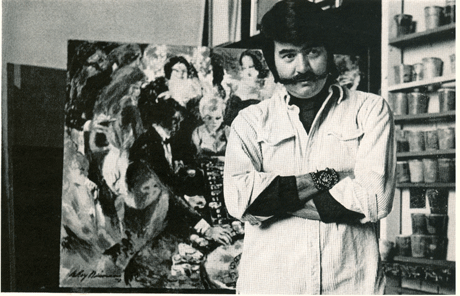Joe Flaherty was a wonderful writer. He may be best remembered as Mailer and Breslin’s campaign manager but his work for the Voice, Esquire, Sport and many other magazines holds up today. It is smart, irreverent, and funny. Unfortunately, Flaherty died of cancer in 1983 at the age of 47.

Still, you can’t go wrong with any of his four books:

It’s a shame that much of his magazine work is unavailable on-line, so in an effort to correct that wrong, here is a piece that originally appeared in the October 1974 issue of Esquire. It is reprinted here with Jeanine Flaherty’s permission.
Enjoy.
Toots Shor Among the Ruins
By Joe Flaherty

HE DOTH BESTRIDE WHAT’S LEFT OF YANKEE STADIUM LIKE WHAT’S LEFT OF A COLOSSUS
Across the isle of Manhattan these days floats a torch song for the past. The wail seems to be strained through a muted horn or, better yet, siphoned through a derby. What occasions this is the belief that the Apple has turned sour, the Big Town has become just another burg.
The reasons are myriad: political, social, sporting. For a while Lindsay revived some past glories, but his clout was cultural—always a limited bailiwick. Lincoln Center is a haven for scratch hitters, while Jimmy Walker got the kudos of the leather-lunged set in saloons, ball parks, and the Garden. Now City Hall is dwarfed by an accountant.
When future generations walk what was “The Main Stem,” “Dream Street,” “The Great White Way,” they will be as baffled as current-day surveyors of Stonehenge. What do these remains bespeak? Will they believe that such places as the Paramount, the Roxy, the Capitol, the Strand, Lindy’s, Birdland, the Hotel Astor, and Tootsie’s ever existed? Or will they think they were some Runyonesque flight of fancy?
Will they ever believe that Broadway was once a street where a gent sported a derby on his head instead of his lap, and that deep throat was the source of accolades for Ruth, DiMag, Mantle, Mays, Canzoneri, Conn, and Louis rather than the private province of Linda Lovelace?

Contrary to the boast of the Beautiful People, the town has turned tacky. Every freak who scatters glitter on his or her navel and whose sexual persuasion is as dubious as Eisenhower’s syntax (confusion over copulative verbs) is christened a celeb overnight. Even the mob guys have lost their cachet. No more Big Frenchys, Owney Maddens, and “Uncle Frank” Costellos. The current crop, if one is to believe their chroniclers, are Sicilian versions of Robert Young in Father Knows Best.
Sports have seen a better day here. What once passed as a mortal Olympus has been reduced to an anthill. The Dodgers are gone like the trolley; and the Giants, residents of Coogan’s Bluff, went with them westward to California for man’s most expedient reason: the fast buck. The sites where Ebbets Field and the Polo Grounds stood are now housing projects, a progression that might brighten the horizons of the Americans for Democratic Action but hardly the hopes of those theologians who thought the teams’ existence in this town was as essential as God or the Devil (depending on your persuasion) and who nightly found biblical or demonic portents in the box scores of the Daily News.
The football Giants are taking it on the lam for New Jersey (the spare-parts capital of the world), so one will feel no longer like a sport on a trek to the Stadium but rather like a penny-conscious housewife on a foray to a suburban shopping mall. The Mets and Jets are sequestered out in Queens, which is as consoling as having a government-in-exile.The Garden is the last real action spot, but most of the championship fights of late have been held out of town or out of the country to beat New York’s huge tax bite.
Of course, there are the Knicks and the Rangers. The Knicks are fine if you can come by the hottest ticket in town and then bear to sit will a collection of unisexuals from Maxwell’s Plum and Thursday’s; while hockey is best left to those whose psyches are haunted by the province of Manitoba and violence on the rocks.

Just pause to think of the glories of another day. During the golden era of sport, the early Twenties through the Fifties, the three New York baseball clubs—the Yankees, Dodgers, and Giants—won a combined total of forty-one pennants and twenty-three World Series. There was incestuous joy in those stats. From 1921 to 1956 there were thirteen (!) “Subway Series,” involving the Yankees (participants in all) against either the Dodgers or the Giants. So the navigators of New York knew better than to believe the notion that the world was round. Abundant riches were to be found in the flat shuttling of the subways.
To unearth all these relics, there was only one man to turn to. A man who knew all the bygone haunts, hoods, and heroes. A man who outdrank and outlasted them not because of his spiritual and social worth but through the tenacity of an anointed liver: New York’s premier saloonkeeper, Toots Shor.

If the choice offends contemporary barhoppers, indulge. It’s a forgotten motif we’re seeking. Better yet, try to picture Elaine Kaufman (hostess of the chichi Elaine’s) laying a fin on a down-and-out wino. But like everything that once comprised his world, Shor’s star these days is in descendance. First off, he is a man without a saloon, which to Shor is like being a priest without a pulpit. No longer do the greats serve as acolytes at his boozy altar, accepting both compliment and insult as blessing. In the old days either one sufficed, the only limbo was being ignored. To be called a “creep” or a “crumbum” back them meant you were a member of his liquid church.
Now his only outlet to his world is the telephone on which the congregation call in daily (though check in seems more like it) for a few minutes of patter that has the ancient jocularity of the buck-and-wing. But it is not a one-way street: the voices on both ends of the line seem to need the therapy. So the phone it must be, since Toots is too sick to make house calls.
Shor sits in a small suite in the Hotel Drake, dressed in blue pants and an open-neck shirt. Even the gold wedding band on his finger bows to a more innocent time. The band is a testament to forty years of marriage to the same woman. He is seventy-one, and his once rugged bulk has been whittled away by a combination of age, illness, and nearly a half century of beating the milkman home by an eyelash. Of late, he has suffered two broken hips, has arthritis in his knee, and on this day he is a week away from having a pancreas operation.
But the visitor does not receive a litany of old-age infirmities (that would show “no class” in the Shor cannon). Indeed, his only lamentation is that he has been on the wagon for three weeks on doctor’s orders, and Shor is a man who can make three weeks without sauce sound like the worldly rejection of a Trappist monk.


But to talk of Shor, one must understand a simple fact: a good part of life is the gesture or the front one puts up. Only deadbeats and punks weep about life’s slings and arrows; stand-up guys take it on the chin and order another round, even if they have to put it on the tab. Shor himself was a flat-pocket import from Philadelphia who rose to millionaire status when, in 1958, he sold his fabled spot at Fifty-one West Fifty-first Street to the Zeckendorf real-estate interests for one million, five. But today, his pockets are as close to his ass as the day he blew Philly. His downfall was building his new saloon at Thirty-three West Fifty-second, the site of the old Leon and Eddie’s (where, in his early days, he served as a bouncer) and now Jimmy’s, political drinking trough of former Lindsay aides Dick Aurelio and Sid Davidoff.
Shor took great pride in building his joints from the ground up. He didn’t like taking over someone else’s failed saloon and redecorating it to his taste. The ghosts of someone else’s boozers haunting one of his places would be an unspeakable social breach. Toot’s grounds had to be new and hallowed. After all, you couldn’t 86 some other creep’s ghosts. And besides, he did have a good track record, since the Fifty-first Street place had been a success. But the one-block jump and a few decades’ distance proved a disaster.
His mistakes were many. Adhering to a bygone calendar, he miscalculated the cost of everything from construction to the prices he would have to charge for food and drinks just to keep the place operating. In the Forties he paid off his Fifty-first Street saloon in a year and a half, charging $1.40 for roast beef, with drinks at fifty and sixty cents. Now hooch cost more per shot than the roast beef of decades ago, and steaks were pulling down $7.50. He estimated the construction cost at three million, seven; but according to The Herald Tribune financial page, the actual cost ended up at $7,500,000.
Moreover, when one looks back at the failure of the new Toots Shor’s, it was touchingly human. Shor is not unlike Lear in old age—unable to accept that men can control everything but time. This is hardly a sin, just a pathetic need in all of us to cocoon ourselves between the parentheses of dates. The old Garden on Fiftieth Street was gone, and the new Garden was downtown on Thirty-second Street. No longer could one saunter over to Toots’s, one had to cab it. And when one was forced to wheels, other options opened: Gallagher’s 33, the bars located in the new Garden itself, or the Lion’s Head in the Village.

Granny Rice and Bill Corum were filing from the other side of the void, and the West Coast had lured away many of the New York celebs that made Toots’s Toots’s. And Shor’s proud claim, “I never ran a dame joint,” which had held him in good stead in the past with hale-hearted fellows, was a stigma invisibly painted on his door to a new breed of athlete and sportswriter who, after an evening of sniffing liniment, yearned for some perfume. In the Sixties, passes and runs at ends were being made at Namath’s Bachelors III, and sexual shagging was the sport in Phil Linz’s Mr. Laff’s.
Depending on your perspective, Shor’s opening such a place smacked of arrogance or an heroic effort by a man who would plug the hourglass to his pleasure. Even simple concessions to another era weren’t granted. In the age of the turtleneck, patrons at Shor’s had to wear a tie (Bill Veeck was the only man excepted from this dictate).
But possibly there is a last, more romantic conclusion to be floated. The new Shor’s was cavernous—spacious beyond any functional worth. So indeed, Toots might have known his time had passed, and like Tutankhamen he decided to build a tomb for himself and his memories, with a curse ensconced for all those who in the future dared to violate the place with broads and turtlenecks.
Make no mistake about it, the allusion to a past potentate is not out of joint. Although Shor is a self-confessed “loudmouth” and “just a saloonkeeper,” he commanded curtsies from the mighty far beyond such deprecations. Not only did the jocks and celebs come to the Fifty-first Street Lourdes for the waters, but also Presidents, princes of the church, financiers, a Supreme Court justice, and a bevy of heavy-between-the-ears writers. He had been lionized in biographies by Bob Considine and John Bainbridge of The New Yorker.

“Somebody once said to me,” Toots growled from his chair, “that I was lucky to have a drink with seven different Presidents, and I said they were lucky to have a drink with me.”
Though the food at his joint was rated Cordon Phoo, it was he who was chosen to cater a luncheon for visiting members of the papal court at the Archdiocese of New York, one of the many “proudest moments in my life” he proclaims. Such stars as DiMaggio and Mantle called him at his saloon every day when they were on the road, and the suspicion here is that it was expected.
The devotion he commanded might best be summed up by a story Bainbridge tells: A Shor regular once met DiMag running west on Fifty-second Street and stopped him to inquire about his hurry. The great Joltin’ Joe answered, “I had to eat lunch with the Yankees at ‘21’ and I want to get over and tell Toots before somebody gives him a bad report.”
This kind of toadying usually is rendered to a vindictive aristocracy, not to the saloonkeeper son of immigrant parents.

To trace Shor’s rise to prominence, one has to shun studies of family heraldry and look to plays by Odets or Abraham Polonsky’s movie Body and Soul. His mother Fanny was born in St. Petersburg. His father Abraham came from Leipzig and had attended the university at Munich. They were both Jews.
This fact surprises, since Shor’s lifestyle of bouncing, boozing, and gambling more appropriately describes the Irish Catholic. It would be fair to assume that a goodly number of people, knowing not the man but the legend, would think Shor was spelled Shaw and that the carouser they read about in Earl Wilson’s column was a roaring boyo. Teddy Brenner, the Garden matchmaker, suffers from the same ethnic confusion. After all, it’s common knowledge—right?—that Jews don’t take up the rowdy professions or carry on in public.
But this canard brings us back to Messrs. Odets and Polonsky. The stage, or scene, is set. Shor’s mother, one of thirteen children, had no time for schooling when she arrived in America. She had to go to work in a Philadelphia factory to support her brothers and sisters. Think of strength. Think of Anne Revere.
His father, even with a higher education, was forced into the shirt-making trade in the new, prejudiced land. Think of the kindly, philosophical dreamer. They opened a cigar and candy store to supplement the father’s meager income. Now we have it: egg creams for education. Add Odets’ Joe Bonaparte in Golden Boy or Polonsky’s Charlie Davis in Body and Soul, and the scenario fleshes out. Toots is the Jew John Garfield later memorialized on film. In the hostile gentile environs of South Philly he did not have just to learn but also to master the catechism of the gutters if he was going to make his mark.
Soda jerking was for jerks and schooling for the leisure class or dewy-eyed immigrants who would raise their aspirations one generation at a time. So Toots preempted the script of the Ash Can school of art and mastered the cue stick, as Prospero summoned his staff. Moreover, he etched the parameters of the poor—the con and the hustle—into his psyche.
If one listens to Considine tell it, the script sticks. Toots’s mother was the formidable influence (Garfield had waded into hell only to bring back a fur coat for Anne Revere). “My mother was a little woman, but real strong, God bless her,” testified Shor.

His father comes in for praise, but with a disclaimer: “He was a wonderful, educated man, tall and well built, but like a Mr. Milquetoast. My mother ran our family. She taught me the greatest lesson I ever had—she taught me how to fight.”
There are layers in that quote, and one suspects they get darker as they are peeled off. Toots’s beloved mother died in a horrible accident: she was decapitated by a runaway ambulance; his father committed suicide five years later. His father’s act might explain Shor’s later advocacy of “professional illiteracy.” Perhaps culture and learning, no matter how desirable, were anathema to being a “stand-up guy.” And father or no father, one has to believe that suicide, in the Shor canon, bespoke “no class.”

According to Shor, his love affair with New York was instantaneous. He worked as a bouncer and greeter in a couple of joints before he was able to raise a bankroll for his own spot on West Fifty-first. “When I started to meet guys like Crosby and Sinatra and all those ballplayers,” he related, “I knew this was the place for me.” After a while, he claims, the adoration flowed the other way. “The celebs,” he said, “would come to any joint I was working in.”
Why? once again pops up. Here is Shor, a rube who admits he debuted in the Big Town with “brown shoes, for chrissake,” becoming the mountain to the WHO’S WHO lemmings. A good measure of his success is attributable to the columnist Mark Hellinger, who recorded Shor’s exploits in baroque terms and baptized him “the classiest bum in town.” If providence had granted Shor the right to choose an alter ego, Hellinger would have been it. He was an urbane, witty man who spent like a sailor and drank like an eighteenth-century lord. Shor, who didn’t shake hands with the devil till his early twenties, soon made Mark his Mitty—right down to adopting Hellinger’s “class” drink, brandy-and-soda.
The penultimate Hellinger-Shor story dates back to 1947, when Shor and his wife spent a month’s vacation in Hollywood as Hellinger’s guests. Variety’s account of the trip ran under the headline, “100% Sur-Le-Cuff.”:
“After New York restaurateur Toots Shor recently completed a month’s cuffo stay under Mark Hellinger’s aegis on the Coast, the producer-writer arranged for the stewardess on Shor’s return flight to hand him $5 when he boarded the eastbound plane, with a note explaining, ‘Just to make it 100%—in case you have to tip at LaGuardia.’”
When Hellinger died at the age of forty-four, Shor in reverence to his mentor became the quickest arm in the East reaching for the tabs. That, too, touches. In my experience, only those who have known poverty develop into big spenders. It’s as if a childhood of watching one’s family genuflect to the buck in the most miniscule monetary matters predicates that the only way as an adult to rid oneself of such dread is to have an economic exorcism—in short, to “piss it all away.”

This thesis has been borne out in the personal experience among not only the once poor but also the forever rich. I once interviewed a young socialite, who was running for political office, at a downtown saloon where the food dead-heated with what Toots used to serve. When the bill for cheeseburgers and beer came, he informed me that I had ordered a side of home fries and two beers to his one, thus I was liable for the extra $1.35 on the check.But such psychological meandering would be so much crap to the gruff Toots. A shrink once made the public conjecture that he over-tipped to compensate for his insecurity, and Shor replied, “It’s not possible to over-tip.”
This extravagance, this blatant disrespect for the buck in a society that gingerly sniffs it out like a hound in search of the proper johnny pump had to give Shor, the otherwise bumptious South Philly exile, a smattering of élan. Legend has it that Toots’s was the place where those aspiring to greatness, like the late actor Paul Douglas or Jackie Gleason, or a newspaperman who only had another deadline in his future, could “put it on the arm” when flat-pocketed.
One story is that Gleason tabbed for over a year, and that it didn’t disturb Shor in the least until he noticed “the Great One” was adding enormous tips to his bills. When Shor confronted him with this disturbing dichotomy, Gleason, instead of being contrite, became indignant and replied, “What are you trying to do? Make me look like a bum in front of your help?” Shor, the report goes, never brought it up again.
If you’re a man who likes his sauce, finding Toots is similar to finding the proper analyst—the one who agrees with you. The philistines are teetotalers, since the Shor sermon from the mount is that “whiskey helps you when you’re feelin’ good and when you’re feelin’ bad.” Indeed, when Shor lists the accomplishments and social graces of other men, drinking proclivities seem to outweigh all else. He even has his All-Stars. In the actor category Don Ameche wins hands down. Jason Robards and “that limey actor—what’s his name, Peter O’Toole?—are nothing but Eighth Avenue boozers.” What this geographical slur meant missed me, but a shot in the dark is that Eighth Avenue, with its well-known theatrical pubs, is the guzzling ground for fey drinkers. Pubs, pshaw! Shor’s was a saloon.
In sports—even though his records are passé, asterisk or otherwise—there was only one Ruth, according to Shor, when it came to the Sultan of Swill. “We used to call him ‘the Animal,’” Shor said fondly, “there was nobody like him. He was the greatest personality of his time. He dominated everything. He lit up every room he walked into. That’s what we need today, a hero of that stature who kids could look up to. But he’ll never be replaced.”

The amazing thing about Shor is that he professes never to find the dark side of alcohol. This is not meant as a prudish chastisement, since I’ve blown more kisses to “last call” than I care to remember. But all the heavy hitters I have known in life have had their periods of despair. Then again, they waded in the sea of booze because they were out on philosophical fishing expeditions. A whale of an answer was to be found in the sauce.
Shor sees it differently. He says he has lived a life in which every night was New Year’s Eve.Perhaps this can be attributed to the firm belief that the high-living Toots has never found himself at odds with the Lord. Indeed, aside from his gluttonous liquid intake, Shor has raised huge sums of money for religious groups of all dominations. He regally state, with all the pomp of a teetotaling deacon: “I consider myself a very religious man.” In the old days, around Toots the Lord was chummily referred to as “the Big Guy.” A nice stunt if you can carry it off—the sky as a locker room with Vince Lombardi as the honcho. The “boys” or “regular guys” would always be welcome in such a milieu; and if the real truth were known, God is a chap who probably enjoys his glass.
One suspects this is not guesswork by the reporter, since “all the great ones,” according to Toots, were blessed with this failing. Shor even says it wasn’t the booze that did in Hellinger but some vague infection he acquired while he was in the hospital. And when Rags Ragland died, Shor wrote to Bing Crosby: “The ginger ale [booze] ruined him. The doctor said he should have started taking care of himself fifteen years ago. My answer to that is, Look at the fun he would have missed.”

Bygone memories and booze are beyond dispute in the Shor scheme of things. He defiantly stated: “What is this new breed worrying about? The rat bastards ought to realize you have to die from something. And the ones who are gone, well, I don’t see anybody taking their place.”
Shor, to put it mildly, is not hot on the current crop in any field. But this is not a rarity among men who have outlived their times and many of their contemporaries. A swinger such as Namath is a mere Shriner on a toot when compared to Bobby Layne: “Layne drank more booze and had more broads in one season than Namath will have in his career.” And Eddie Arcaro received the accolade of being “the best hangover jockey of all time.” But such stats are difficult to check unless one is privy to the tales of the confession box.
For all his hard-nose, Shor has a disturbing Dink Stover quality. He speaks of Ruth and Dempsey as if their records shouldn’t be in books, but on the Sistine Ceiling. To him, athletes are the ones who have graced this planet. “People in sport,” he tells you, “are the greatest people in the world.”
To illustrate his point, he cited how he attended a prizefight at the Garden with Averell Harriman, Joe DiMaggio, and Ernest Hemingway, and “nobody noticed Hemingway—only DiMaggio.” He would be better off if he remembered Red Smith’s dictum that baseball, after all, is still a game played by little boys.
A basic flaw in Shor (an abundance of grace to his champions) is his sentimentality. But as O’Neill pointed out, this is part of being a boozer. John Barleycorn turns on the sad music in his adherents. Toots has a vehement distaste for all young sportswriters who look at the seamier side of Olympus. “All they write about is money,” he complained. “Who wants to hear about that? They should be writing about the heroes.”
This seems deliberately naïve, since sports have now bypassed whoredom in greed. But then, Shor deals in absolutes. He will bitch about the decline of New York, but during the course of our conversation was on the phone with Giants president Wellington Mara, who is shagging ass to New Jersey, and they sounded like matched turtledoves. And when I asked him about this obvious contradiction, he gave me a conspiratorial wink and said, “I know you’re right, but you don’t tell another guy how to run his store.”
Of the current irreverent sportswriters, Larry Merchant of The New York Post is the target of much of his ire. Merchant wrote of Mara, “How can you trust an Irishman named Wellington?” and pointed out his penchant for the green.
“He’d like to write like Dan Parker, but he doesn’t have the balls,” said Shor.
Merchant, passing off Shor’s venom, touted him thus: “He’s just pissed off because I never went into his fuckin’ joint.”

But the bull’s-eye of Shor’s ire is ex-Yankee pitcher Jim Bouton, the Joe Valachi of the locker room, who wrote Ball Four. “That bum nearly ruined Mickey’s marriage with his book,” Toots growled.
On the other hand, Shor claims that the young sportswriters “are a bunch of creeps who leave a sporting event and go home and have a milk shake.”
One of them, Vic Ziegel, who also writes for The New York Post and who has been known to curl his fingers around a glass as lovingly as around his typewriter, retorted, “Just tell him I would have been happy to come into his place, but they didn’t even know how to make a good milk shake.”
In a way it’s odd (even conceding old age) that Shor spurns the young, since he sees himself as an all-encompassing father figure. When he speaks of Crosby and Sinatra, he says, “I raised those kids.” And this year, when Mantle and Whitey Ford were inducted into the Hall of Fame, Toots says it was another of his greatest moments. “To see my two kids make it to Cooperstown was the thrill of a lifetime,” he declared. At a party afterward Shor cracked to Mantle that Ford’s pitching arm had added two years to Mantle’s career, and Mantle replied, “You took five years off it.”
That is the nice surrogate-father role, but there also is a tyrannical Big Daddy. Shor proudly related how he “aided” one of the most famous athletes ever to play baseball in New York. The player in question had just been divorced by his first wife. One evening while Shor was attending a prizefight at the Garden, someone told him the player’s ex-wife was flying back to California and taking the couple’s young son with her. Toots immediately left the Garden and cabbed to Idlewild. “I grabbed her at the airport and said, ‘What the hell do you think you’re doing?’ and took the kid by the hand and brought him back to his father. The bitch flew to California alone.”
In the Shor canon, this was a consummate act of loyalty; in the legal canon, it might be considered kidnapping.
Yet this, too, must be considered: why Shor commanded power beyond his calling. His daring to act, to be the take-charge guy, to fit Bob Dylan’s memorable phrase “the whole world is looking for a daddy.” Shor served as not only barkeep but marriage broker as well. Infidelity is beyond his scope.
“I can’t understand,” he said, “how a husband and wife could do that to each other.”
But surely, one queried, of the scores of celebs who frequented Shor’s some played around? Big Daddy had a dictate for this, too: “I wouldn’t allow one of my married regulars to come into my joint with another broad on his arm. If he was screwing around, he had better have another guy in his company with the broad to make it look all right.”
Indeed, there were many ways to fall out of Shor’s graces. On a particularly crowded and hot night in Shor’s, the much-lionized Norman Mailer was asked to leave because he took off his jacket. Jimmy Breslin was chastised for his colorful language. And when Charlie Chaplin complained about waiting for a table, Shor told the great comedian to “be funny for about twenty minutes.” The message was that in Shor’s it was Toot’s deck.
If Toots orchestrated the living, he was a maestro over the dead. As a mourner he was (and is) a one-man wailing wall. When a Shor regular died, it was beyond saying that the family would be looked after and the surviving troops commanded by Shor to the bier to assure a classy send-off. When the regular was particularly close to the proprietor, Shor would weep and drink in tandem for weeks. There is an apocryphal story circulated by George Jessel that he once whispered in Shor’s ear, “McKinley died,” and Shor broke out weeping and bought rounds for the house.
So Shor, we have found, is composed of as many ingredients as a complex cocktail: bravado, bathos, loyalty. It is the last that cements his bond with his following.

Red Smith, the dean of New York sportwriters, had this to say: “When I was working in Philadelphia, I once asked Toots what made his place the number-one saloon in the world. You have to remember the old place was more famous than Harry’s Bar in Paris or Shepheard’s in Cairo. Toots simply said, ‘The newspaper guys were always my friends.’ He never realized the place was a mother lode if you were writing a column—a blessed thing to have for material.
“As for Toots, he had an all-embracing affection for the guys who went in there. Bill Veeck once said to me it didn’t matter whether he owned the Cleveland Indians or some bushers in Milwaukee, the treatment he received was always the same.”
Smith recounted a story that highlights Shor’s tenacious loyalty to friends, wherever they might be in the standings: “I was sitting with Toots at a back table on a night that the Yanks won the World Series. That year Joe Page had had a dismal record. I guess it was a combination of old age and too much partying, or maybe his arm was just tired. Whatever, he didn’t really contribute much to the Yanks’ success, and he felt it. That evening the Yankees were having a victory party somewhere else in town. Suddenly, Toots stood up from our table and said,
‘Excuse me, Joe Page is outside.’
“I sat alone for awhile, then a waiter came up to me and said, ‘The boss just gave Joe Page a hero’s welcome.’”
Smith, who is as nifty with a phrase as a professional gift-wrapper with a bow, tied it up: “As a man, you would have to say Toots was enormously loyal and hideously sentimental.”
To others, the magic of Fifty-one West Fifty-first was a happy marriage of the man, the time, and the place. Louis Sobol, the old Broadway columnist for the now defunct Journal-American, opts for the man: “Toots was the last of the old booming hosts. In those days Billingsley at the Stork Club used gimmicks to attract business. He would give perfume to the women or have things like a ‘Balloon Night.’ The balloons would have gift certificates inside for jewelry, cash, puppies—you name it.” Then he added with legionnaire loyalty, “Toots never needed those things. He gave away nothing but the sheer force of his personality.”

For Whitey Ford, the place was unique for a delectable aspect of human bondage: “You would always run into Ameche or Gleason or Graziano. The real charm of the place was that if you went in there at twelve noon you knew you wouldn’t get out for the day.”
For my own part, I, ruefully, was too young to sample the siren call of West Fifty-first, and I found my visitations to Shor’s Taj Mahal on Fifty-second wanting. On my first visit, after a major fight at the Garden, I was denied entrance because I was wearing a turtleneck (but also, I might add, a sport jacket—I personally thought I looked like Max Beerbohm). On subsequent trips, the joint reminded me of a packed convention hall, emitting a single dull roar. But maybe I should have tried a daytime foray. Ford was right about high-noon drinking. It’s like afternoon moviegoing. There is a clandestine camaraderie to be found in such enterprises: to be at play while the rest of the world is toiling in the fields of the Lord.
But what bothered me most about the new Shor’s was that there was no identifiable stamp on it, it could just as well have been run by Restaurant Associates. Once again, Red Smith offered a capper: “The trouble with that cavernous place was that it engulfed Toot’s personality.”
It was now late afternoon, and after watching me back down the better part of a bottle of his brandy, Shor decided—doctors or no doctors—that three weeks dry was enough for any civilized man. He poured a tumbler and pulled hard, and in the same style that black athletes taffy-pull the word “shit” into “shee-e-e-it,” he announced, “Bee-e-yoo-tiful.”
Two hotel employees came into the room to make minor adjustments on his skitterish TV set; and for three minutes’ work Shor peeled a couple of bills from a wad, snapping the money toward himself Broadway style, and dropped them on the grateful repairmen. An old lifestyle never bows to current economic reality.
Some more booze was dropped, and Shor estimated that for nearly a half century he has done a bottle or two of brandy each day. This is a dubious claim to fame, since alcoholism is now the third largest killer in the United States after heart disease and cancer. TIME magazine has given the subject its cherished cover, and there was a television movie, The Morning After, starring Dick Van Dyke (a recovered alcoholic himself).
Shor had watched the special, and it infuriated him. “I never knew any drunk who carried on like that,” he said. “Beating his wife and losing his job and all that shit. My daughter called me the next day, and I told her I should demand equal time. And she said [he was now chortling] that I would need a twenty-four-hour telethon to respond.”
As we bantered, the phone continued to ring. Well Mara again, and to him Shor dropped a line that truly astounded me. He said that he had talked to Randy and told him he was conducting himself like a man—“Randy” was Randolph Hearst!
Pat O’Brien also checked in from the Coast, and there were many I-love-you-too’s. O’Brien dedicated an entire chapter of his autobiography to Shor; it is titled “A Man Called Toots” and is so sentimental it makes Mother Machree sound like something sinister from Sam Beckett.
The drinking continued, and the phone kept ringing. Shor signed off many calls with his comrades-in-arms, “Give your wife a pat on the fanny for me.” One could hear the sisters marching. But again, Shor would be the first to tell you he never ran a dame joint.
As the booze warmed him, Shor became more expansive and perhaps more trusting of one of the “new breed” seated across from him. Men’s boozing always creates that kind of atmosphere—the recalling of episodes, well-worn stories, which have always made me think saloons are the oldest repertory companies in the world.
There was the night he and Pat O’Brien hired a hansom cab to ferry them around town and at daybreak took the driver upstairs to Toot’s duplex for a nightcap. To his irate wife, Shor proclaimed, “You’re lucky we didn’t bring up the horse.” But this is standard college-boy stuff. Some tales indicate that Shor is not the bellowing boozer he would like everyone to think, but a man of agile wit.
The I.R.S. once challenged his return because he had claimed his tickets to baseball games as legitimate business expenses. When the auditor informed Shor that baseball games were pleasure, Toots snorted, “Pleasure! Did you ever see the St. Louis Browns play?” The audit was dropped.
And when his good boozing companion, Ernest Hemingway, went down in a plane crash in Africa and was reported dead by the press, only to emerge a few days later alive and sporting a jug of gin and a bunch of bananas, Shor cabled him a one-word critique: “Showboat!” Then there was the time an old friend spotted Shor talking to Robert Sherwood in his Fifty-first Street joint; he approached Shor and asked what the hell Toots could be saying to a genius. Shor replied, “I was fading him with grunts.” Hardly the quips of a guy who wears brown shoes.
Shor was now in an amber mood, matching the brandy inside and the setting sun outside, and he conceded that a “modern” jock might once again dominate the town like “the Babe.” The Mets’ right outfielder, Rusty Staub, is his choice. Staub has the Shor credentials for canonization: physical presence, talent, he is a bachelor with a bevy of broads and, of course, a man who can handle his jar. On presence alone “O.J. Simpson might make it,” Shor said. “Clay [Ali] could have done it, but he got into that political crap.” The amber turned burnished red.

What of the political Shor? He says he has been a lifelong Democrat. Did he vote for McGovern? Does the pope keep a copy of Martin Luther’s theses on his night table? “If the election was held over again today, I wouldn’t vote for him.” Nixon then? “That s.o.b is paying seven hundred dollars in taxes, and they busted me for a half million.”
Here Shor was referring to the tax assessment on his duplex apartment at 480 Park Avenue and his saloon, which came to $575,000, left him flat-pocketed, and ultimately cost him both his home and his joint. Hedging like hell, like a man who has made a bad tout and doesn’t want to admit it, he refused to commit himself. The tout here is that Nixon, as he did with most of the nation, foxed Shor with his curvy nickel-and-dime philosophy.
It was time to leave. Shor’s wife entered the room and informed him that his private nurse was waiting for him in the bedroom. Mrs. Shor is a petite, pretty woman and a former show girl, Marian Volk (Hellinger had also married a show girl); her public nickname is “Baby.” But to Toots, she is “Husky.” And he obviously puts some credence in his muscular love name for her, since he blamed the empty jug on me.
Jug gone, day done, I now had to frisk why Toots was the genie of the bottle set. New York spits out saloon-keepers with casual distain. Owners and joints fold more often than they succeed and are never heard from again. So why did Shor become sovereign? Why were his legions so loyal? Indeed, during World War II when he had used up his allotment of meat stamps, and the place had to survive for a long period on a menu of omelets and fish, Jimmy Walker announced that Toots was in trouble, and now everybody had to eat there twice a day.
Also consider this: Shor’s food, when meat was plentiful, was summed up by the late Jimmy Cannon in this bit of Michelinian meanness. One night the lights were dimmed at Shor’s for atmosphere, and Cannon cracked, “Thank God, they’ve executed the chef.” So the answer is not to be found in the menu, but definitely in the man.
In an anchorless world, Shor, whose demeanor (by his own account) resembled a bobbing buoy, was a bulwark against drifting values. He was a family man who had raised four children. He was fast with a buck and yet spurned the fast buck. Even now, in financial bushville, when he was approached by a publisher to do a tattle-tale book for big bread on the night life of the gods he had known, he “threw the bum out.”
Through charity he helped line the pockets of the poor and enrich the coffers of heaven. Right or wrong, he was what the Sixties and Seventies aren’t. Though there would never be a McGovern in his life, it would be unfair to indict him for a Nixon. If Shor dealt a monarchial deck, at least it would be a fair one. And if his failing health can’t be revived by science, it might be by nostalgia. After all, if we can’t stand up and sing The Star-Stangled Banner anymore, some sense of solace could be found standing up in a new Toots.

AN EPILOGUE: Weeks later, I talked with Shor by phone to find out about his operation. “I feel great,” he declared. “I was out of the hospital in eleven days. The doctors tell me it takes you young stiffs three weeks to recover. Earl Wilson called me this morning and asked if I was going to give up drinking now, and I told him that at my age it makes no sense.”
I cautioned him that he should at least get back into training for such a venture, and he replied like a man who had just had his flat-pocket spirits inflated, “I’ve been in training all my life.”
What epitaph can be found for an unrepentant Falstaff?

Joe Flaherty and His Muse
Special thanks to Dina C for her transcription skills.


























































